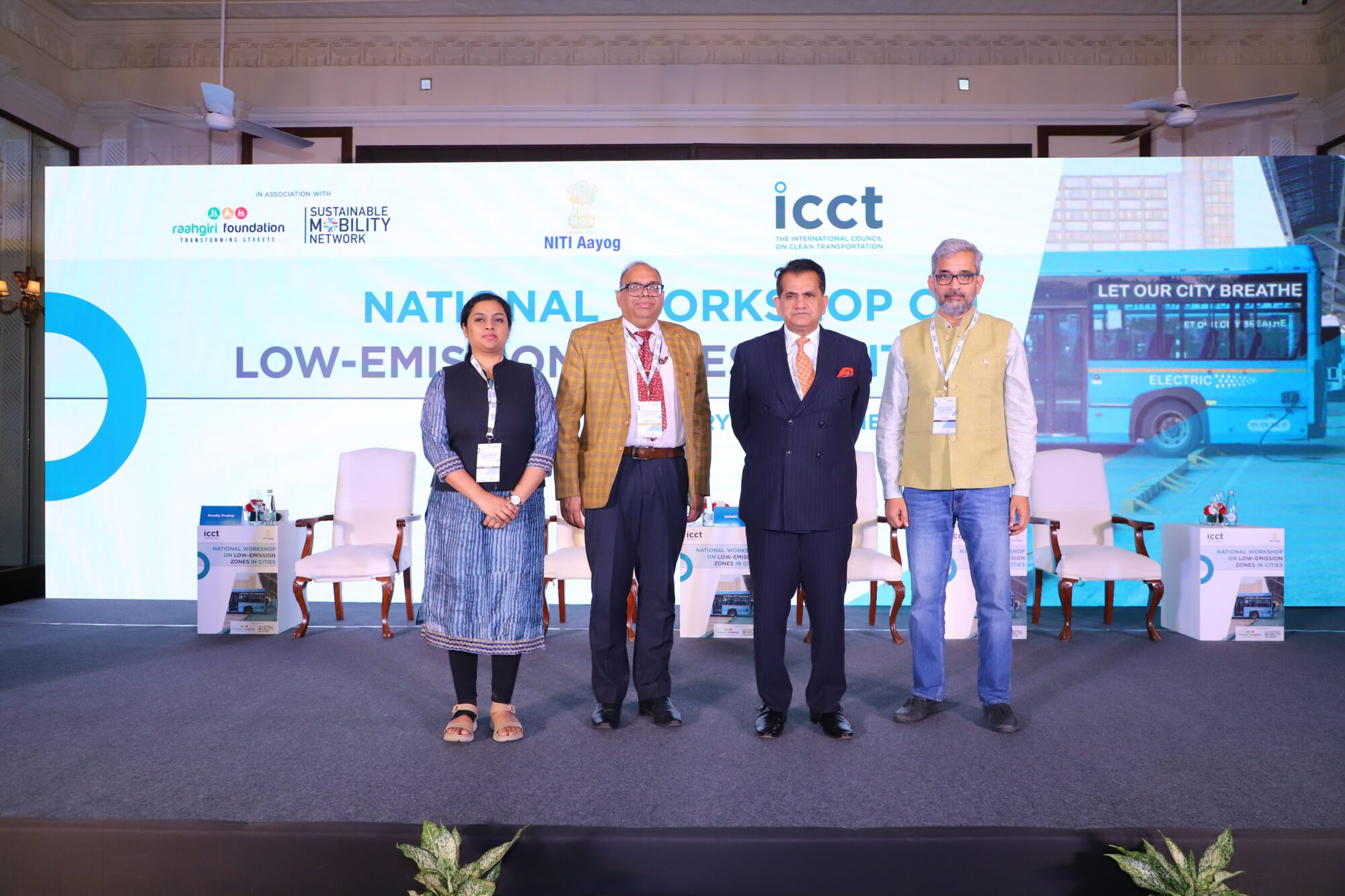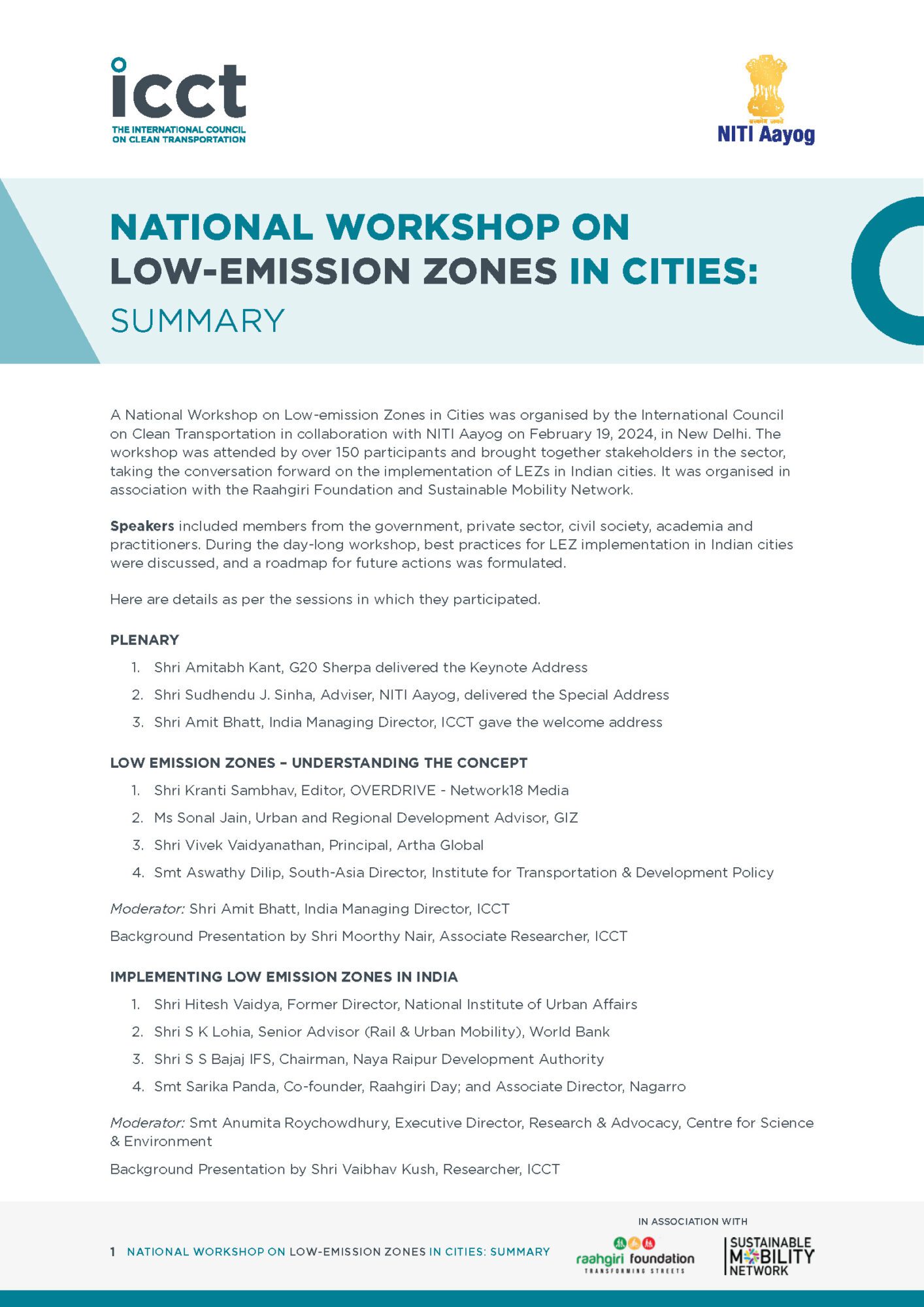Blog
Enabling low-emission zones around schools and across Indian cities
It’s becoming an annual occurrence during the winter months that schools across north India are forced to close mid-session due to severe air pollution. This disruption of education is just another example of why it’s crucial to reduce vehicle tailpipe emissions. About 90% of India’s transport sector emissions come from road transport and tailpipe emissions typically include oxides of nitrogen, sulfur, and carbon.
This issue was discussed during a day-long National Workshop on Low-emission Zones in Cities convened by the ICCT and NITI Aayog, the apex public policy think tank of the Government of India, in February in New Delhi. Low-emission zones (LEZs) are geographically defined areas where the movement of high-polluting vehicles is restricted, and the workshop featured representatives from the government, private sector, civil society, academia, and the media. One of the key messages that emerged from that day was also in a recent article we wrote about how LEZs and cleaner transport can reduce school children’s exposure to harmful pollution. With this background, let’s delve deeper into how LEZs can be enabled in India.

(left to right) Revathy Pradeep, Researcher, ICCT; Sudhendu Sinha, Adviser, NITI Aayog; Amitabh Kant, G20 Sherpa; and Amit Bhatt, Managing Director ICCT in India, at the workshop in New Delhi in February 2024.
Low-emission school zones
A recent guideline published by the Indian Roads Congress, a professional body of highway engineers in India, recommended that road-owning agencies implement a few interventions to improve the safety of children in “school zones.” It defines a “school zone” as an area around a school where the movement of a higher number of children is expected, especially during school opening and closing times. While the purpose of this guideline is to improve the road safety of children, it establishes a premise that can help designate school zones as LEZs.
A low-emission school zone would restrict the operation of highly polluting internal combustion engine vehicles around schools, especially during school hours. For maximum effectiveness, such restrictions must be applied to both commercial and private vehicles.
Speaking during the workshop, Amit Bhatt, Managing Director of the ICCT in India, said, “During their developmental years, children are at particular risk of adverse effects from air pollution, and it may impact their health later in life. Interventions that improve air quality, like LEZs, are urgently needed, both to improve public health now and prevent longer-term increased vulnerability to chronic diseases. These are public health policy interventions aimed at reducing traffic-derived contributions to urban air pollution.”
A 2021 study found that around 48% of children in India walk to schools in urban and rural regions. Motorized modes of passenger transport available in India for commuting to school include private two- and four-wheelers, school vans, autorickshaws, and buses, which mostly run on either petrol or diesel and expose school children to harmful pollutants.
LEZs are, therefore, a potentially impactful solution. A study of LEZs around schools in London showed a 23% drop in nitrogen dioxide (NO2) levels when traffic was closed at pick-up at drop-off times. Combining low-emission school zones with ample walking and cycling infrastructure and a shift to cleaner fuels for ferrying school children can help maximize the environmental and health benefits of all these approaches.
Planning LEZs in India
India’s existing legal framework allows for the implementation of LEZs. The pedestrianization of a street in Delhi’s Chandni Chowk, the declaration of the Taj Trapezium Zone, and the banning of certain non-BS-VI diesel vehicles from entering Delhi are examples of judiciary, central, and state governments, respectively, exercising their powers in this regard.
In his keynote address at the workshop, Amitabh Kant, G20 Sherpa of India, underscored the need for LEZs to be part of a holistic approach. He said, “LEZs must be accompanied by creating excellent walking and biking infrastructure; deploying EV charging infrastructure; making roads safer for pedestrians by installing pedestrian crossing signals; and giving greater visibility to the schedule of public transport buses.”
In his special address during the workshop, Sudhendu Sinha, Adviser, NITI Aayog, touched upon how LEZs have evolved globally and emphasized the need to be cognizant of practical issues when implementing similar initiatives in India. “We cannot be ignorant of what happens outside the LEZs,” he said.
Implementing LEZs in India
Discussions during the workshop resulted in three recommendations that were echoed unanimously by speakers as being critical to adopting LEZs in India.
- Use of technology: Starting from the keynote address by Kant and across all subsequent panel discussions, speakers emphasized the need to exploit the power of technology. The technology available today such as Global Navigation Satellite Systems (GNSS) and remote sensing can help gather near real-time transportation and emission data that either directly yields insights or can be analyzed and used to create models that help make decisions. This information should feed into choices about LEZs. Technology is also critical for monitoring and enforcing the rules of LEZs.
- An integrated approach: A multi-sectoral, integrated, and collaborative approach is the way forward for enabling LEZs in India. As Kant said, “Everything is solvable if all stakeholders can be brought together [at] the same table to work towards a common goal.” Pollution, as an airshed issue, is not limited to a city’s boundaries. Decisions must be considered at the regional level so that LEZs can become a holistic solution for multiple urban issues.
- Human-centered decision-making: The concept of an LEZ was created to address an issue that affected the populace. As Indian cities adopt LEZs, it’s important for decision-makers to not only improve environmental conditions but also give equal effort to improving the overall quality of life of the people.
LEZs have manifold benefits because they help protect public health and thus make cities more attractive places to reside, work, and spend time in. With the key learnings and background outlined here, policymakers in India can consider setting up LEZs across India.
Author

Anandi Mishra
India Communications and Public Relations Manager
Related Publication

NATIONAL WORKSHOP ON LOW-EMISSION ZONES IN CITIES
Discusses best practices and formulate a roadmap for implementing LEZs in Indian cities, highlighting the importance of technology in monitoring and enforcing these interventions.

